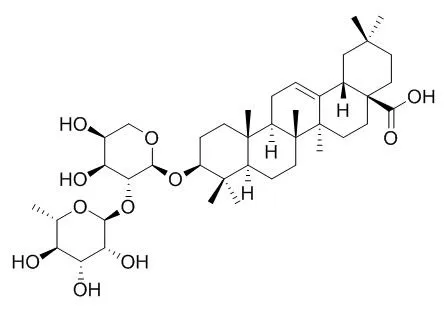The bronchospasmolytic and secretolytic effects of ivy leaves dry extracts can be explained by an increased β2-adrenergic responsiveness of the bronchi. Recently, it was shown that α-hederin inhibits the internalization of β2-adrenergic receptors (ß2AR) under stimulating conditions. α-Hederin pretreated alveolar type II cells and human airway smooth muscle cells revealed an increased ß2AR binding and an elevated intracellular cAMP level, respectively.
METHODS AND RESULTS:
In order to identify whether additional compounds also mediate an increased β2-adrenergic responsiveness, we examined the ingredients of an ivy leaves dry extract (EA 575) protocatechuic acid, neochlorogenic acid, chlorogenic acid, cryptochlorogenic acid, rutin, kaempferol-3-O-rutinoside, 3,4-, 3,5- and 4,5-dicaffeoylquinic acid, hederacoside B, and Beta-Hederin. Within all the tested substances, only β-hederin inhibited the internalization of GFP-tagged ß2AR in stably transfected HEK293 cells. Using fluorescence correlation spectroscopy Beta-Hederin (1 μM, 24 h) pretreated HASM cells showed a statistically significant increase in the ß2AR binding from 33.0 ± 8.9% to 44.1 ± 11.5% which was distributed with 36.0 ± 9.5% for τbound1 and 8.1 ± 2.6% for τbound2, respectively (n = 8, p < 0.05). The increased binding was selectively found for the receptor-ligand complex with unrestricted lateral mobility (τbound1 of 0.9 ± 0.1 ms, D1 = 9.1 ± 0.2 μm(2)/s, n = 8), whereas the binding of ß2AR with hindered lateral mobility (τbound2 of 64.2 ± 47.6 ms, D2 = 0.15 ± 0.02 μm(2)/s, n = 8) was not affected. Compared to control cells, a statistically significant increase of 17.5 ± 6.4% (n = 4, p < 0.05) and 24.2 ± 5.8% (n = 4, p < 0.001) in the cAMP formation was found for β-hederin pretreated HASM cells after stimulation with 10 μM of terbutaline and simultaneous stimulation with 10 μM terbutaline and 10 μM forskolin, respectively.
CONCLUSIONS:
Within this systematic study focusing on the influence of the ingredients of an ivy leaves dry extract on HASM cells it was possible to identify Beta-Hederin as further component presumably responsible for the β2-mimetic effects. |






 Cell. 2018 Jan 11;172(1-2):249-261.e12. doi: 10.1016/j.cell.2017.12.019.IF=36.216(2019)
Cell. 2018 Jan 11;172(1-2):249-261.e12. doi: 10.1016/j.cell.2017.12.019.IF=36.216(2019) Cell Metab. 2020 Mar 3;31(3):534-548.e5. doi: 10.1016/j.cmet.2020.01.002.IF=22.415(2019)
Cell Metab. 2020 Mar 3;31(3):534-548.e5. doi: 10.1016/j.cmet.2020.01.002.IF=22.415(2019) Mol Cell. 2017 Nov 16;68(4):673-685.e6. doi: 10.1016/j.molcel.2017.10.022.IF=14.548(2019)
Mol Cell. 2017 Nov 16;68(4):673-685.e6. doi: 10.1016/j.molcel.2017.10.022.IF=14.548(2019)